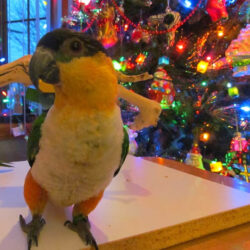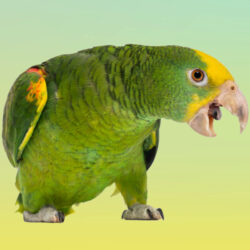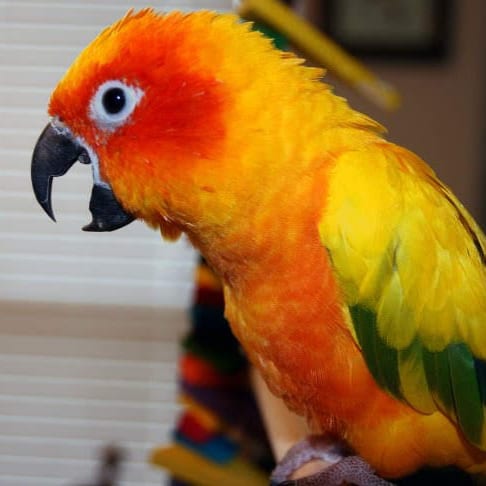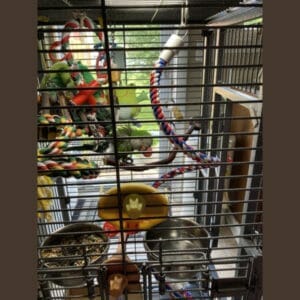
My Parrot Has Started Screaming ALot. What Can I Do?
Last Updated on by Mitch Rezman
Q: My parrot has started screaming. A lot. What can I do?
- Living with a companion parrot is very much like living with a mischievous child, isn’t it? And much like raising children, it’s a matter of catching your parrot doing something right, and not rewarding bad behaviour like problem screaming.
Parrots scream to communicate:
As spring approaches, bringing longer days and more sunshine, the volume in our home increases dramatically, especially at sunset. In the wild, parrots naturally call to their flock at sunset to bring everyone in safely for the night. The call of a macaw or cockatoo can be heard for miles, and that’s precisely the point. Even the call of a conure can be heard for a mile. Have you ever heard the piercing call an African Grey delights in making? You need to consider your living arrangements before introducing one of these species to your home.
Alarm screaming:
Your parrot is alerting its flock to danger. To your bird that could mean a plane overhead, a strange car in the driveway, the shadow of a hawk, you name it. Can you draw the blinds? Move the cage? If your parrot is in a front room where delivery people are constantly walking by, you can solve that by closing the blinds for that portion of the day.
Parrots in the wild:
Wild parrots are very busy all day flying and searching for food, with social play time and grooming in between. When it’s dark they sleep; they awaken at first light.
How can you mimic that environment at home?
Do you have a good variety of rotating chew toys to keep your parrot’s beak busy? Interactive toys are an excellent way to stimulate your bird. Do you have a play stand or foraging area away from the main cage area? You can make your own foraging toys. A favorite foraging toy is a box filled with appropriate-sized smooth stones on top of sunflower seeds or another treat. You can try putting less food in the bowl and more in cardboard, paper towel rolls with masking tape, that sort of idea. A clever macaw, grey, cockatoo, or amazon needs a more intricate setup to work through. For a small parrot, simply mixing small chew toys in a bowl with food can do the trick.
As foraging makes up the majority of a wild parrot’s existence, this activity can’t be stressed enough. I will recommend a well-balanced treat that also includes pellet, so you’re not overfeeding with sunflower seeds or peanuts.
Tired Parrots:
Like children, when your parrot is overtired, or bored, it will scream. A parrot needs 12 hours of sleep, so perhaps a sleep cage in a quiet room is a simple solution if its main cage is in the midst of family activity. A cage cover may also be helpful.
My parrots go back to their cage every afternoon for a ‘rest’ period. The radio is turned off and the blinds pulled. It’s their quiet time, like clockwork, every day around 1 pm. I give them the “Shhhh” command and leave them to it.
Parrot Screaming releases energy:
Lots of daily exercise is essential, from wing flapping to misting or showering. Mental stimulation is also necessary for these exceptionally smart creatures.
If your bird isn’t free-flighted, you need to work those wings! With small parrots, make sure your thumb is over its foot so it doesn’t fall, or feel a fear of falling. Start slowly, moving your hand in a large circular motion. You can also train her to flip upside down, or all around, whatever kind of fun you want — it’s excellent exercise. Your bird should be panting when you’re done.
Daily misting or showering works wonders as well. A wet bird has its entire body to groom after a shower and that’s a quiet bird. Before any large gathering at our house, I ensure my parrots are fully exercised and showered. Just as a good dog is a tired dog, so too is your parrot.
Clicker training is not only rewarding for you, it’s mentally stimulating for your parrot. Parrots love to learn new things at any age, so it’s never too late.
And finally, Parrots screaming for attention:
If you’re following all of the steps above and your parrot is still screaming for your attention, it likely means this has been a rewarding behavior in the past. This is where you have to be on your toes. You cannot reward the screaming or you’re part of the problem. You must ignore the screaming and wait, patiently, until the moment (or second) your parrot is quiet. Then and only then, immediately speak to your parrot in a whisper. If your parrot responds with a scream, turn your back to ignore or leave the room. And start over. It doesn’t take long for a parrot to learn that responding in a whisper earns a reward—your presence, and recommended, a treat at the beginning of this training.
Observe and investigate your parrot’s surroundings and you’ll find the solutions are close at hand.
Denise Wamsley
Windy City Parrot
Author Profile
Latest entries
 Bird & Parrot CareDecember 18, 2016Christmas With My Parrots
Bird & Parrot CareDecember 18, 2016Christmas With My Parrots Bird & Parrot CareMarch 29, 2014Can My Bird Safely Eat People Food?
Bird & Parrot CareMarch 29, 2014Can My Bird Safely Eat People Food? Bird BehaviorMarch 13, 2014My Parrot Has Started Screaming ALot. What Can I Do?
Bird BehaviorMarch 13, 2014My Parrot Has Started Screaming ALot. What Can I Do?


